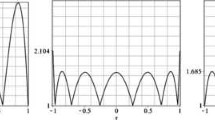Abstract
Well-known two-sided estimates for the Lebesgue constants of two classical trigonometric interpolation Lagrange polynomials are improved. Approximations of these Lebesgue constants are based on logarithmic functions with shifted arguments.
Similar content being viewed by others
References
K. I. Babenko, Foundations of Numerical Analysis, Moscow–Izhevsk (2002).
D. L. Berman, “On the question of the best system of nodes of parabolic interpolation,” Izv. Vyssh. Ucheb. Zaved. Mat., 4 (35), 20–25 (1963).
L. Brutman, “Lebesgue functions for polynomial interpolation. A survey,” Ann. Numer. Math., 4, 111–127 (1997).
B. G. Gabdulkhaev, Optimal Approximations of Solutions of Linear Problems [in Russian], Izd. Kazan Univ., Kazan (1980).
V. L. Goncharov, Theory of Interpolation and Approximation of Functions [in Russian], GTTI, Moscow–Leningrad (1934).
R. Gunttner, “Evaluation of Lebesgue constants,” SIAM J. Numer. Anal., 17, No. 4, 512–520 (1980).
V. V. Ivanov, Theory of Approximate Methods and Its Application to the Numerical Solution of Singular Integral Equations, Naukova Dumka, Kiev (1968).
N. P. Korneichuk, Extremal Problems of Approximation Theory, Nauka, Moscow (1976).
I. P. Natanson, Constructive Theory of Functions, Gostekhizdat, Moscow–Leningrad (1949).
T. Rivlin, “The Lebesgue constants for polynomial interpolation,” in: Functional Analysis and Its Applications (H. C. Garnier et al., eds.), Springer-Verlag, Berlin (1974), pp. 422–437.
I. A. Shakirov, “On the influence of the choice of nodes of Lagrangian interpolation on exact and approximate values of Lebesgue constants,” Sib. Mat. Zh., 55, No. 6, 1404–1423 (2014).
I. A. Shakirov, “On the limit value of the remainder term of the Lebesgue constant corresponding to the trigonometric Lagrange polynomial,” Izv. Saratov. Univ. Nov. Ser. Ser. Mat. Mekh. Inform., 16, No. 3, 302–310 (2016).
I. A. Shakirov and I. O. Prikhodov, “On the Lebesgue constant of the Lagrange polynomial,” in: Actual Directions of Scientific Research in the 19th Century: Theory and Practice, Proc. Conf. November 9–12, 2015, 8, Voronezh (2015), pp. 448–452.
P. Vertesi, “Optimal Lebesgue constants for Lagrange interpolation,” SIAM J. Numer. Anal., 27, 1322–1331 (1990).
A. Zygmund, Trigonometric Series, Vol. 2, Cambridge University Press, Cambridge (1965).
Author information
Authors and Affiliations
Corresponding author
Additional information
Translated from Itogi Nauki i Tekhniki, Seriya Sovremennaya Matematika i Ee Prilozheniya. Tematicheskie Obzory, Vol. 153, Complex Analysis, 2018.
Rights and permissions
About this article
Cite this article
Shakirov, I.A. Approximation of the Lebesgue Constant of a Lagrange Polynomial by a Logarithmic Function with Shifted Argument. J Math Sci 252, 445–452 (2021). https://doi.org/10.1007/s10958-020-05172-7
Published:
Issue Date:
DOI: https://doi.org/10.1007/s10958-020-05172-7
Keywords and phrases
- Lagrange interpolation polynomial
- remainder term
- Lebesgue constant
- approximation by logarithmic functions
- extremal problem
- best approximation element



